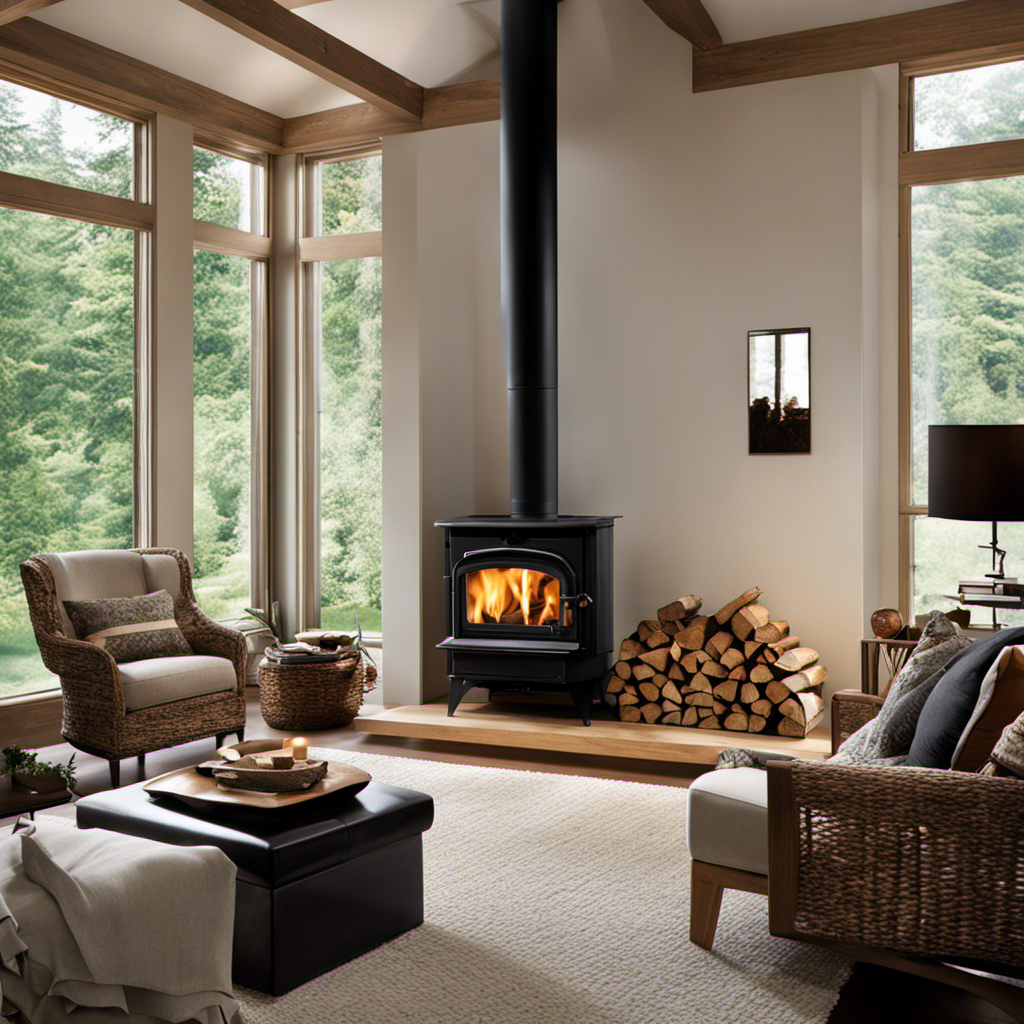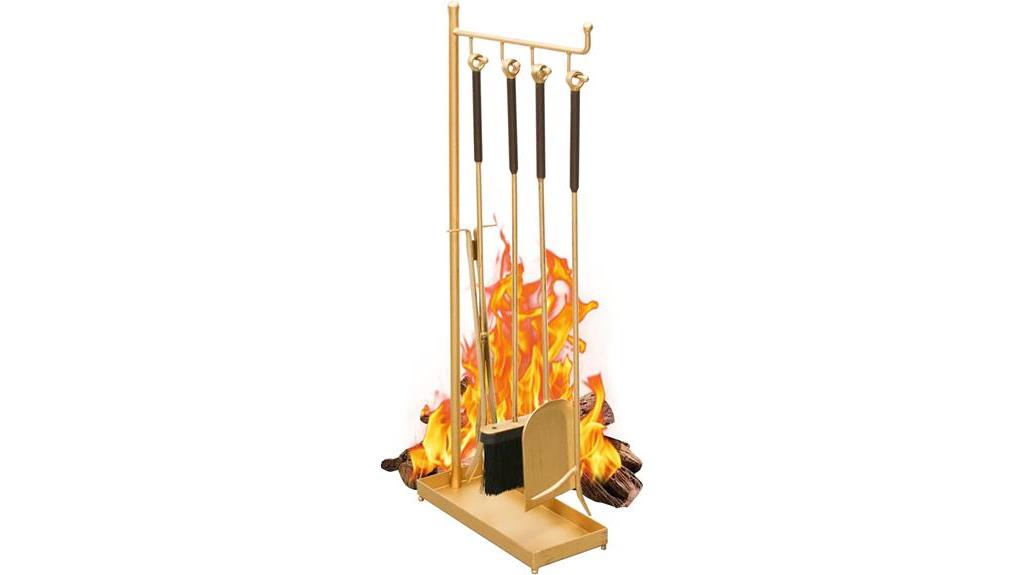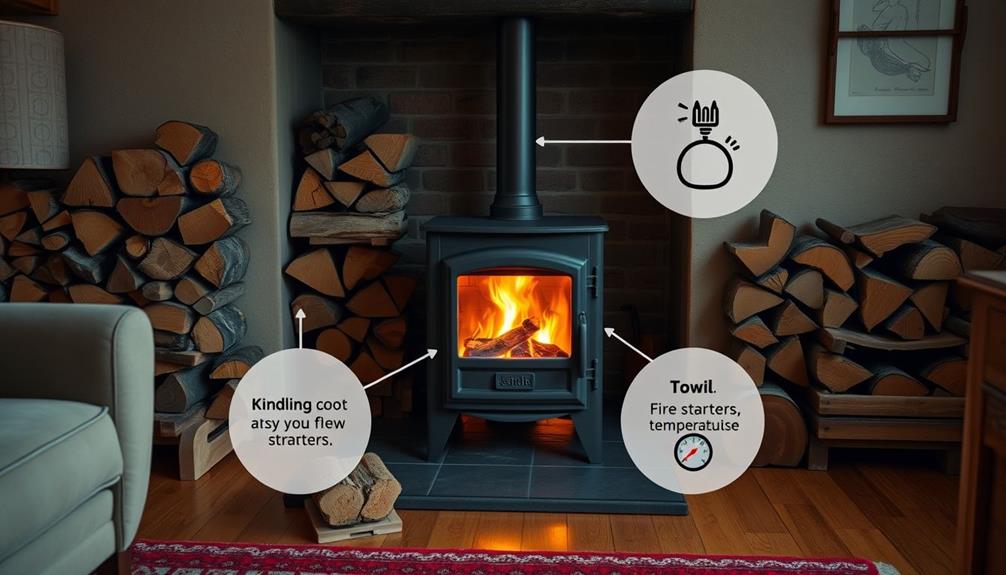I believed that installing a wood stove in my living room would be ideal, but I was mistaken! As it turns out, these charming heat sources need much more space than I initially anticipated.
In this article, I’ll share the minimum clearance requirements for combustible materials, the recommended distances from walls and furniture, and the necessary space for venting and chimneys.
Don’t make the same mistake I did – let’s dive into the details of how much space a wood stove really needs!
Key Takeaways
- Wood stoves have minimum clearance requirements to ensure safety.
- Following recommended distances from walls and furniture is crucial for fire safety.
- Venting and chimneys have specific clearance requirements for safe installation.
- Adequate air circulation and ventilation are essential for safe operation.
Minimum Clearance to Combustible Materials
I need to make sure there’s enough space between my wood stove and any combustible materials to meet the minimum clearance requirements.
Clearances are important for the safety of my home and everyone in it.
The clearance requirements for non-combustible materials, such as walls or floors, are typically smaller compared to combustible materials like wood or fabric.
The exact clearance distances may vary depending on the specific wood stove model and local building codes.
It’s crucial to regularly inspect and maintain these clearances to ensure the wood stove operates safely and efficiently.
Regular inspections also help identify any potential hazards or issues that may arise over time.
Recommended Distance From Walls and Furniture
To ensure fire safety, it’s important to follow the recommended distance from walls and furniture when installing a wood stove. The recommended distance for a wood stove varies depending on the type and size of the stove. However, as a general guideline, it’s recommended to have a minimum of 36 inches of clearance from the walls and furniture.
This distance is crucial to prevent any potential fire hazards. It allows for proper airflow around the stove and reduces the risk of igniting nearby combustible materials. Additionally, it’s important to take other safety precautions such as using a heat shield or fire-resistant materials on the walls and floor surrounding the stove.
Following these recommendations will significantly reduce the risk of fire and ensure the safety of your home and loved ones.
Clearance Requirements for Venting and Chimneys
When it comes to venting and chimneys, there are specific clearance requirements that need to be followed to ensure the safe installation of a wood stove. The first important requirement is the clearance for floor protection. It’s crucial to have a non-combustible material, such as a hearth pad, installed underneath the wood stove. This protects the floor from heat and potential fire hazards.
Additionally, there are clearance requirements for nearby objects. For instance, the stove should have a certain distance from walls, furniture, and other combustible materials. This is to prevent any accidental contact between the stove and these objects, reducing the risk of fire.
Adhering to these clearance requirements is vital for the safe and efficient operation of a wood stove.
Adequate Air Circulation and Ventilation
Having at least two windows open in the room provides adequate air circulation and ventilation for the wood stove. Proper airflow requirements are crucial for the safe operation of a wood stove.
When using a wood stove, it’s important to ensure that there’s enough fresh air entering the room and that the smoke and gases produced by the stove are properly ventilated. This helps to prevent the buildup of harmful gases, such as carbon monoxide, and ensures that the fire burns efficiently. Safety measures should be taken to ensure that there’s a constant supply of fresh air, such as keeping windows open or installing vents.
By providing adequate air circulation and ventilation, we can ensure the safe and efficient operation of the wood stove.
Now, let’s discuss the space considerations for safe operation and maintenance.
Space Considerations for Safe Operation and Maintenance
I need to ensure that there’s enough clearance and proper access for safe operation and maintenance of the wood stove.
When it comes to safety precautions, one of the most important factors to consider is the amount of space needed around the wood stove. It’s crucial to maintain a safe distance between the stove and any combustible materials, such as furniture or curtains. The National Fire Protection Association recommends a minimum clearance of three feet. This ensures that there’s enough room for air circulation and minimizes the risk of accidental fires.
Additionally, proper access is essential for maintenance purposes. Regular cleaning of the stove and its components is crucial to ensure its efficient operation. It’s important to follow manufacturer’s instructions for maintenance tips, such as cleaning the chimney and inspecting the stove for any signs of damage.
Frequently Asked Questions
What Are the Different Types of Wood Stoves Available in the Market?
There are various types of wood stoves available in the market, each offering different features. Some common types include freestanding stoves, fireplace inserts, and pellet stoves. They vary in terms of design, fuel type, and heating capacity.
How Do I Properly Clean and Maintain a Wood Stove?
Proper wood stove maintenance is crucial for efficiency and safety. Regular cleaning techniques include removing ashes, cleaning the glass, and inspecting the chimney. It’s important to follow manufacturer guidelines and consult professionals if needed.
Are There Any Specific Safety Guidelines for Installing a Wood Stove in a Mobile Home?
When it comes to installing a wood stove in a mobile home, it’s crucial to follow specific safety guidelines. Proper ventilation and clearance requirements are essential for the safety of your home and family.
Can I Install a Wood Stove on a Second Floor or in an Attic?
When installing a wood stove, it’s crucial to follow safety guidelines. Consider factors like proper ventilation, clearance from combustible materials, and the structural integrity of the floor or attic.
Are There Any Specific Requirements for Installing a Wood Stove in a Basement or Below-Grade Area?
When installing a wood stove in a basement or below-grade area, specific requirements must be met. It’s important to consider factors such as proper ventilation, clearance from combustible materials, and the size and capacity of the stove.
Conclusion
You won’t believe how much space a wood stove needs!
The minimum clearance to combustible materials, recommended distance from walls and furniture, clearance requirements for venting and chimneys, adequate air circulation and ventilation, and space considerations for safe operation and maintenance are all crucial.
Don’t compromise on safety – make sure you give your wood stove the space it deserves to keep your home warm and cozy without any risks!
Growing up surrounded by the vast beauty of nature, Sierra was always drawn to the call of the wild. While others sought the comfort of the familiar, she ventured out, embracing the unpredictable and finding stories in the heartbeat of nature.
At the epicenter of every remarkable venture lies a dynamic team—a fusion of diverse talents, visions, and passions. The essence of Best Small Wood Stoves is crafted and refined by such a trio: Sierra, Logan, and Terra. Their collective expertise has transformed the platform into a leading authority on small wood stoves, radiating warmth and knowledge in equal measure.











